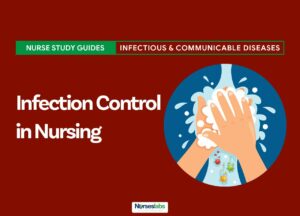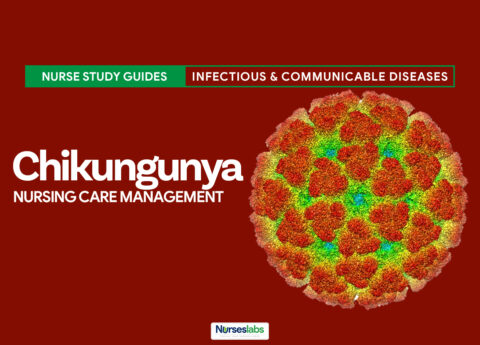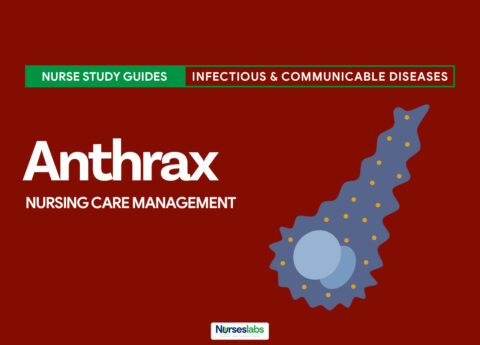In this study guide, learn more about cytomegalovirus, its pathophysiology, causes, signs and symptoms, nursing care management, and interventions.
Cytomegalovirus, also known as Human Herpesvirus (HHV-5), CMV OR HCMV is a common virus that is found around the world. Individuals affected with this kind of virus may not know they have it since it seldomly causes symptoms.
What is Cytomegalovirus?
Cytomegalovirus (CMV) is a double-stranded DNA virus and is a member of the Herpesviridae family.
- CMV shares many attributes with other herpes viruses, including genome, virion structure, and the ability to cause latent and persistent infections.
- At least 60% of the US population has been exposed to CMV, [1] with a prevalence of more than 90% in high-risk groups (eg, male homosexuals).
- Cytomegalovirus usually causes an asymptomatic infection; afterward, it remains latent throughout life and may reactivate.
- Symptomatic CMV disease in immunocompromised individuals can affect almost every organ of the body, resulting in fever of unknown origin, pneumonia, hepatitis, encephalitis, myelitis, colitis, uveitis, retinitis, and neuropathy.
Pathophysiology
Cytomegalovirus is a lytic virus that causes a cytopathic effect in vitro and in vivo.
- When the host is infected, CMV DNA can be detected with polymerase chain reaction (PCR) in all the different cell lineages and organ systems in the body.
- Upon initial infection, CMV infects the epithelial cells of the salivary gland, resulting in a persistent infection and viral shedding.
- Infection of the genitourinary system leads to clinically inconsequential viruria.
- Despite ongoing viral replication in the kidney, renal dysfunction is rare except in renal transplant recipients, in whom CMV is associated with rare cases of glomerulopathy and possible graft rejection.
Statistics and Incidences
In the United States, nearly one in three children are already infected with CMV by age five.
- In developing countries, most infections are acquired during childhood, whereas, in developed countries, up to 50% of young adults are CMV seronegative.
- The incidence of CMV seropositivity rises with age and in a US-based study was reported to increase from 36% in children aged 6-11 years to 91% in individuals older than 80 years.
- Other factors associated with CMV seropositivity include ethnicity (77% in Mexican Americans and 71% in blacks), [6] female sex, foreign-born status, and low socioeconomic status.
- Depending on the population surveyed, CMV may be found in 40%-100% of people, depending on socioeconomic conditions.
Causes
Causes of cytomegalovirus may include:
- Contact with fluids. CMV is mainly transmitted by contact with fluids that contain the virus (e.g., saliva, urine, semen, cervical mucus, blood, breastmilk).
- Blood transfusion. Transfusion of multiple blood units is a risk factor for CMV mononucleosis and has been implicated in postoperative fever or fever in patients following trauma.
- Increased hospital stay. CMV frequently reactivates in critically ill patients and may be linked to increased length of hospital and/or intensive care stay, duration of mechanical ventilation, morbidity , and mortality.
Clinical Manifestations
In some cases, infection in healthy people can cause mild illness that may include:
- Fever
- Sore throat
- Fatigue
- Headache
- Swollen glands
- Loss of appetite
- Muscle weakness
Assessment and Diagnostic Findings
Serologic tests that detect CMV antibodies (IgM and IgG) are widely available from commercial laboratories.
- ELISA. The enzyme-linked immunosorbent assay (ELISA) is the most common serologic test for measuring antibodies to CMV.
- PCR. The standard laboratory test for diagnosing congenital CMV infection is polymerase chain reaction (PCR) on saliva, with urine usually collected and tested for confirmation.
- Antigen testing. The pp65 assay is used to detect messenger matrix proteins on the CMV virus, with either immunofluorescence assay or messenger RNA amplification; these proteins are typically expressed only during viral replication.
- Shell vial assay. The shell vial assay is performed by adding the clinical specimen to a vial that contains a permissive cell line for CMV; this test has been found to be as sensitive as traditional tissue culture.
- Cytopathology. Intracellular inclusions surrounded by a clear halo may be demonstrated with various stains (Giemsa, Wright, hematoxylin-eosin, Papanicolaou).
Medical Management
No treatment is currently indicated for CMV infection in healthy people.
- Activity. The most common symptom after resolution of the acute phase of CMV infection is fatigue, which may persist up to 18 months after the primary infection but is usually much shorter; some patients resume their usual activities almost immediately, but the average time to recovery from fatigue is 1-2 months.
- Antiviral treatment. Antiviral treatment is used for people with compromised immune systems who have either sight-related or life-threatening illnesses due to CMV infection.
- Prevention. A major successful use of ganciclovir has been prophylactic or preemptive treatment of CMV disease in transplant recipients.
- Outpatient care. When ganciclovir is administered on an outpatient basis for the treatment of CMV retinitis, follow-up with a CBC count once per week (monitoring for hematological toxicity) is necessary; monitoring electrolytes at the same time is prudent.
- Inpatient care. Patients with cytomegalovirus (CMV) disease must be well hydrated; nutrition is an important factor because many patients are debilitated by transplant or HIV disease; and as with any patient, attention must be focused on avoiding iatrogenic infections and problems.
Pharmacologic Management
The goals of pharmacotherapy of cytomegalovirus are to prevent outbreaks of the disease and its complications and to reduce morbidity.
- Antivirals. CMV is a double-stranded DNA virus; drugs used for the treatment of DNA viral infections affect viral DNA polymerase, affect viral DNA replication, reduce the rate of viral DNA synthesis, and may interfere with virion maturation.
- Immune globulin. Consists of administration of immunoglobulin pooled from serum of immunized subjects.
- Antimetabolite. These agents inhibit cell growth and proliferation.
Nursing Management
The nursing management of a patient with cytomegalovirus include the following:
Nursing Assessment
Assessment of the patient with Cytomegalovirus may include:
- History. History varies depending on whether the host is immunocompetent or immunocompromised. Note that many people infected with CMV do not show symptoms.
- Physical exam. Most patients with CMV infection exhibit few clinical findings on physical examination.
Nursing Diagnosis
Based on the assessment data, the major nursing diagnosis for patient with Cytomegalovirus are:
- Risk for infection as evidenced by fatigue, sore throat, mild headache.
- Hyperthermia related to increase in metabolic demands.
- Impaired swallowing related to the swelling of the throat.
- Fatigue related to poor physical state.
Nursing Care Planning and Goals
The major nursing care planning goals for a patient with Cytomegalovirus are:
- Patient remains free of infection, as evidenced by normal vital signs and absence of signs and symptoms of infection.
- Patient maintains body temperature below 39° C (102.2° F).
- Patient displays ability to safely swallow, as evidenced by absence of aspiration, no evidence of coughing or choking during eating/drinking, no stasis of food in oral cavity after eating, ability to ingest foods/fluids.
- Patient verbalizes what important tasks during periods of fatigue have a higher priority than nonessential activities.
Nursing Intervention
The nursing interventions for a patient with Cytomegalovirus include the following:
- Prevent infection. Wash hands and teach patient and SO to wash hands before contact with patients and between procedures with the patient; encourage fluid intake of 2,000 to 3,000 mL of water per day, unless contraindicated; if infection occurs, teach the patient to take antibiotics as prescribed. Instruct the patient to take the full course of antibiotics even if symptoms improve or disappear.
- Diminish hyperthermia. Eliminate excess clothing and covers; give antipyretic medications as prescribed; modify cooling measures based on the patient’s physical response, and start intravenous normal saline solutions or as indicated.
- Improve swallowing. Classify food given to the patient before each spoonful if the patient is being fed; advance slowly, giving small amounts; whenever possible, alternate servings of liquids and solids; keep patient in an upright position for 30 to 45 minutes after a meal.
- Reduce fatigue. Evaluate the patient’s description of fatigue: severity, changes in severity over time, aggregating factors or alleviating factors; restrict environmental stimuli, especially during planned times for rest and sleep; assist the patient with setting priorities for preferred activities and role responsibilities; promote sufficient nutritional intake; identify energy conservation methods such as sitting and dividing ADLs into convenient segments and make the patient aware about the signs and symptoms of overexertion with activity.
Evaluation
Nursing goals are met as evidenced by:
- Patient remained free of infection, as evidenced by normal vital signs and absence of signs and symptoms of infection.
- Patient maintained body temperature below 39° C (102.2° F).
- Patient displayed ability to safely swallow, as evidenced by absence of aspiration, no evidence of coughing or choking during eating/drinking, no stasis of food in oral cavity after eating, ability to ingest foods/fluids.
- Patient verbalized what important tasks during periods of fatigue have a higher priority than nonessential activities.
Documentation Guidelines
Documentation in a patient with Cytomegalovirus include:
- Individual findings, including factors affecting, interactions, nature of social exchanges, specifics of individual behavior.
- Cultural and religious beliefs, and expectations.
- Plan of care.
- Teaching plan.
- Responses to interventions, teaching, and actions performed.
- Attainment or progress toward the desired outcome.
Summary
Here are some of the most important points about Cytomegalovirus:
- Cytomegalovirus (CMV) is a double-stranded DNA virus and is a member of the Herpesviridae family.
- CMV usually causes an asymptomatic infection; afterward, it remains latent throughout life and may reactivate.
- In the United States, nearly one in three children are already infected with CMV by age five.
- Depending on the population surveyed, CMV may be found in 40%-100% of people, depending on socioeconomic conditions.
- Causes of cytomegalovirus may include blood transfusions with infected individuals and increase in hospital stay.
- Symptoms of cytomegalovirus are fever, sore throat, fatigue, and swollen glands.
- The enzyme-linked immunosorbent assay (ELISA) is the most common serologic test for measuring antibody to CMV.
- No treatment is currently indicated for CMV infection in healthy people.
- The goals of pharmacotherapy are to prevent outbreaks of the disease and its complications and to reduce morbidity.
References
Sources and references for this Cytomegalovirus study guide:
• Centers for Disease Control and Prevention. (2020, April 28). Cytomegalovirus. Retrieved from https://www.cdc.gov/cmv/index.html
• Akhter, K. (2018, May 5). Cytomegalovirus. Retrieved from https://emedicine.medscape.com/article/215702-overview





































Leave a Comment